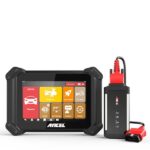Are you looking to understand what’s happening under the hood of your car? The Torque app, paired with an OBD2 scanner, transforms your Android device into a powerful vehicle diagnostics tool. This dynamic duo allows you to monitor your car’s engine control unit (ECU) in real-time, giving you access to a wealth of information about your vehicle’s performance and health.
What is a Torque OBD2 Scanner and Why You Need One?
An OBD2 scanner is a small device that plugs into your car’s OBD2 port, typically located under the dashboard. This port is a standardized interface that provides access to your vehicle’s computer system. When combined with the Torque app on your Android phone or tablet, the OBD2 scanner becomes a window into your car’s inner workings.
The Torque app leverages the data transmitted by the OBD2 scanner to display crucial information, including:
- Real-time engine data: Monitor parameters like engine temperature, RPM, speed, manifold pressure, and much more.
- Fault code reading: Identify the dreaded “Check Engine” light’s cause by reading diagnostic trouble codes (DTCs).
- Fault code clearing: After addressing the issue, you can use Torque to clear fault codes and turn off the “Check Engine” light.
- Performance monitoring: Utilize your phone’s GPS and accelerometer to track acceleration, braking, and g-forces.
- Customizable dashboards: Create personalized displays to show the data most important to you.
For car enthusiasts, DIY mechanics, or anyone wanting to stay informed about their vehicle’s condition, a Torque Obd2 Scanner is an invaluable tool. It empowers you to understand your car better, diagnose potential problems early, and even save money on unnecessary trips to the mechanic.
Choosing the Right OBD2 Adapter for Torque
The effectiveness of your Torque OBD2 scanner setup heavily relies on the quality of your OBD2 adapter. While numerous adapters are available, ranging from budget-friendly options to more robust professional-grade devices, selecting a reliable one is crucial for seamless performance.
Here are some recommended OBD2 adapter series known for their compatibility and performance with the Torque app:
- Scantool.net OBDLink Series: Renowned for their speed and reliability, OBDLink adapters like the OBDLink MX and OBDLink LX are excellent choices. They offer fast data transfer and robust connections.
Alt text: OBDLink MX adapter from scantool.net, a fast and compact OBD2 scanner.
- PLX Devices Kiwi Bluetooth: The Kiwi Bluetooth adapter from PLX Devices is another highly recommended option, offering a stable Bluetooth connection and reliable performance with Torque.
Alt text: Kiwi Bluetooth OBD2 adapter by PLX Devices in its retail box, a reliable adapter choice.
- Generic Bluetooth Adapters (Use with Caution): You’ll find many inexpensive Bluetooth OBD2 adapters online, often based on the ELM327 chip. While some may work adequately, be aware of potential issues with build quality and reliability. Some users have reported connectivity problems and even interference with vehicle systems. If opting for a generic adapter, proceed with caution and research reviews.
Alt text: A generic Bluetooth OBD2 adapter from eBay, a budget option with potential reliability concerns.
- PLX Devices Kiwi Wi-Fi OBD (Less Common Now): While PLX also offered a Wi-Fi version, the Bluetooth Kiwi adapter is generally preferred for its ease of use and not requiring phone modifications like rooting (which was sometimes needed for Wi-Fi versions in the past).
Alt text: PLX Devices Kiwi Wi-Fi OBD adapter, a less common Wi-Fi based OBD2 scanner.
Compatibility Note: Virtually any car manufactured from 2000 onwards is likely to have an OBD2 port. Many vehicles from the mid-1990s also adopted the standard. If you’re unsure, consult your car’s manual or a quick online search for your car’s year, make, and model will confirm OBD2 compatibility and port location. OBD2 ports can sometimes be subtly hidden, such as under ashtrays or behind panels.
Getting Started with Torque and Your OBD2 Scanner
Using Torque with your OBD2 scanner is straightforward:
- Plug in your OBD2 adapter: Locate your car’s OBD2 port and firmly plug in the adapter.
- Download and install Torque: Get the Torque app from the Google Play Store. Both a free (ad-supported) and a paid (ad-free) version are typically available.
- Pair your adapter: Enable Bluetooth on your Android device and pair it with your OBD2 adapter following the adapter’s instructions.
- Connect in Torque: Launch the Torque app and configure the connection settings to recognize your OBD2 adapter.
- Start monitoring: Once connected, you can start viewing real-time data, reading fault codes, and exploring Torque’s many features.
Explore the Possibilities with Torque
The Torque app offers a wide array of functionalities beyond basic diagnostics. You can:
- Upload real-time data to the web: Torque allows you to stream live data to a dedicated online Torque viewer website, enabling you to review and analyze your driving data remotely.
- Customize dashboards: Create multiple dashboards tailored to specific driving scenarios or data you want to monitor.
- Use plugins: Extend Torque’s capabilities with various plugins available for specialized features and vehicle types.
Torque empowers you to take control of your car’s diagnostics and performance monitoring. By combining the Torque app with a reliable OBD2 scanner, you gain valuable insights into your vehicle, helping you stay informed and proactive about its maintenance.
To delve deeper into Torque and connect with other users, visit the Torque forum to share tips, ask questions, and explore the full potential of your Torque OBD2 scanner setup.
